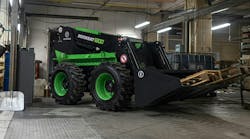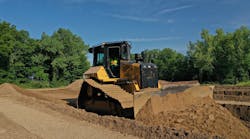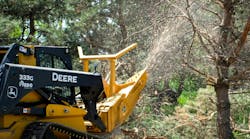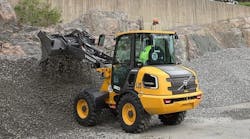Proper undercarriage maintenance on track machines is critical to providing a long life for the machine and keeping maintenance costs down.
Undercarriage components include the track chain, bottom rollers, top carrier rollers, idlers, drive sprocket, and track pad.
"Approximately 50 percent of the maintenance cost of a track machine is in the undercarriage. It's huge. So, it's to the owner's advantage to keep the undercarriage maintained properly. Keeping it clean and adjusted are very, very important," Mike Lazzara, product support sales manager for Michigan CAT, said.
"You need to keep it aligned. If you do that, it will last," Mark Martino, account representative for Michigan CAT, said. Even though track machines don't get out of alignment very often, it's a good idea to monitor that.
"The reason that should be done is that if you have a left eye-dominant operator or a right eye-dominant operator, they tend to always travel on that side of the machine and then everything starts wearing on that side. After 2,000 or 3,000 hours you'll see the difference," Martino said.
Turning bushings and pins on the undercarriage is a thing of the past now, at least when it comes to Cat dozers. "Caterpillar has a newer undercarriage called SystemOne. You don't have to turn the pins and bushings with the SystemOne undercarriage. You still need to turn the pins and bushings on older machines, usually at 1,500 to 2,000 hours of operation," Lazzara said. SystemOne is available on Cat dozers.
"With some of the older machines, we'd get upwards of 2,500 hours before we'd turn the bushings. SystemOne has a rotating bushing and it does it by itself," Martino said. A second turn could be done at 1,250 to 1,500 hours of operation on older undercarriages, so that the undercarriage components could go approximately 3,700 hours. Martino pointed out that the SystemOne undercarriage approaches 6,000 hours of operation. At that point the undercarriage must be replaced. Caterpillar's SystemOne undercarriage saves the contractor on downtime and service cost. Even though there is a slightly higher upfront cost for SystemOne, turning the bushings and pins has been eliminated, saving the contractor approximately $3,000 in service costs.
"We have parts and service sales representatives that will go out and inspect undercarriages for customers at no charge. The contractor will get a written report on the condition of their undercarriage," Lazzara said.
"We look at our undercarriages on a daily basis," Joseph Marino Riccardi, president of San Marino Excavating, Inc., of Brighton said. Riccardi said that his firm checks undercarriages before putting the machines into service. "Michigan CAT provides checklists to us. Our service department looks at them at 250 hours and 500 hours. At 1,000 hours they receive a more thorough inspection," Riccardi said. Michigan CAT examines undercarriages on a six-month basis. San Marino Excavating, Inc. has seven Cat dozers and five excavators in its track machine fleet. The company also has approximately five loaders and two Cat backhoes. The company has been in business for 11 years.
Riccardi said that Michigan CAT does most of the service on San Marino's fleet. "If we can't do it in the field, or if it's major work, Michigan CAT will service the undercarriages," Riccardi said. He pointed out that taking oil samples helps to pinpoint problems.
"A lot of people don't pay attention to oil samples. We take oil samples on final drives, because we can catch problems before we have a catastrophic failure," Riccardi said. Michigan CAT sends the oil samples to a laboratory for testing. When the laboratory reports that there is high iron content or a high copper content in the oil, that is abnormal and the final drive needs to be checked.
During operation, materials can stick to and pack between mating components such as rollers, links, sprocket teeth, and bushings. Packing prevents parts from engaging correctly. This can cause higher loads and increased wear rates. Packing is inevitable in many applications; however, there are things that can be done to reduce the effects of packing.
- Use center-punched shoes in certain situations to help relieve extruding materials such as wet sand, clay or snow.
- Clean out the undercarriage as often as possible. Garbage, twigs, stones, and demolition debris cannot be extruded through the center punched shoes.
- Use roller guards only when necessary because they may trap debris and increase the effects of packing. They are designed primarily for use in high-impact underfoot conditions.
One of the best ways to protect a machine against unnecessary wear is to make sure it is used properly. All of the following causes additional wear on the components of the undercarriage:
- Slipping the track reduces production and increases wear on all undercarriage components, especially on grouser bars.
- Avoid unnecessary reverse operation. Non-productive reverse operation compounds bushing and sprocket wear. If the machine must be taxied from one location to another, reverse operation will cause more bushing wear regardless of speed.
- Operating the machine at a nonproductive high speed may cause link, tractor roller and idler tread wear. Wear increases proportionally to speed.
- Always turning the machine in one direction may cause link side rail/track roller flange and idler flange wear. Wear increases on one side of the machine because of the greater horsepower and distance traveled.
Here is an operating checklist:
- Always use the narrowest shoe possible that still shows adequate flotation.
- Minimize high operating speeds in nonproductive situations, especially in reverse.
- Alternate the turning direction since turning in only one direction wears out one side of the machine faster than the other.
- Do not spin the tracks since it reduces production while increasing wear on all undercarriage components, especially on grouser bars.
The following is a maintenance checklist:
- Call your parts and service representative for expert advice and service.
- Adjust the track for correct tension. Always adjust the track in its working environment. Correct track adjustment is critical.
- Tighten the track hardware correctly.
- Make daily visual inspections of the equipment. Check for loose bolts, leaking seals and abnormal wear.
- Keep the undercarriage clean of mud and debris so the rollers can turn properly.




